#however it is european santa so he brings a companion that punishes the naughty children
Explore tagged Tumblr posts
Text
Peruere: *writing a letter* Peruere: Dear Santa, I'm writing to let you know I've been naughty... And it was worth it you fat, judgemental bastard.
#Surprisingly Crucabena does have Santa#however it is european santa so he brings a companion that punishes the naughty children#„oh with coals?��� you ask#no#by beating them up and/or kidnapping and killing them (by drowning them in a river)#welcome to german christmas lore everyone#google Knecht Ruprecht and Krampus and read their wikipedia articles I‘m begging. If you haven‘t grown up with them you dont understand#anyways Santa in this case is Dottore and the naughty kids get brought to the lab#crucabena doesnt wanna admit it but she found the letter fucking hilarious#arlecchino#the knave#peruere#genshin impact#incorrect quotes#fatui#fatui harbingers
35 notes
·
View notes
Text
Krampus - Unveiling the Dark Companion of Christmas Shaina Tranquilino December 28, 2023
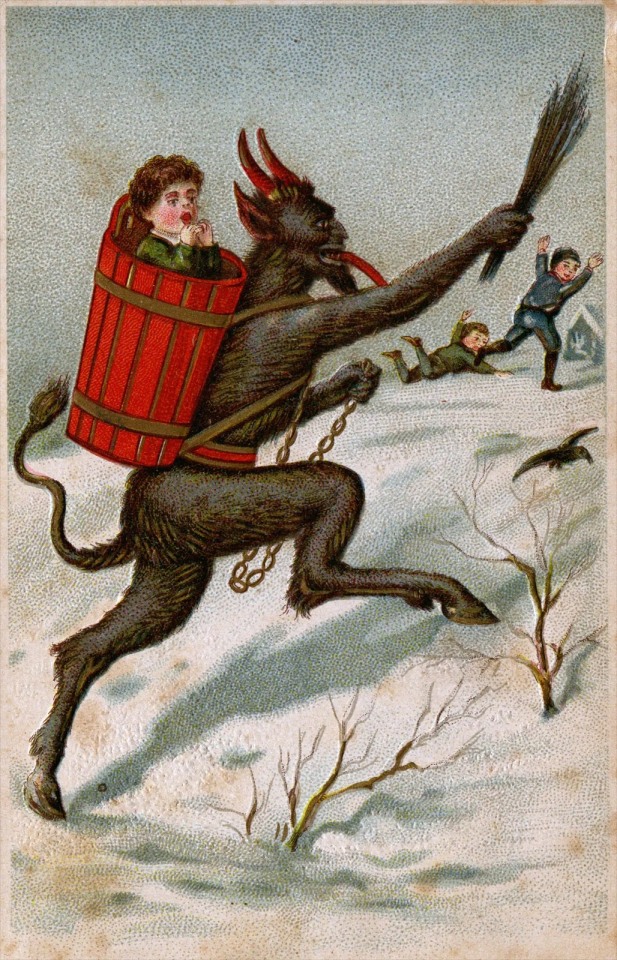
During the holiday season, we often find ourselves immersed in the joy and cheer associated with Santa Claus, Rudolph, and all things merry. However, there is one mysterious figure lurking in the shadows of our festive celebrations – Krampus. Originating from European folklore, this legendary creature serves as a dark counterpart to Santa Claus, embodying everything naughty and terrifying. In this blog post, we delve into the origins and cultural significance of Krampus.
Who is Krampus?
Krampus is a horned anthropomorphic figure with roots dating back to pre-Christian Alpine traditions. Known as the "Christmas Devil" or "Anti-Santa," he represents punishment for misbehaving children during the holiday season. Contrasting sharply with Santa's benevolent nature, Krampus embodies fear and discipline.
Historical Origins:
The exact origins of Krampus remain elusive due to its deep connection with ancient pagan rituals and folklore. However, it is widely believed that this mythical beast hails from Central European countries like Austria, Germany, Hungary, Slovenia, and Czech Republic. The legend of Krampus gained prominence during the 17th century when Christians began incorporating elements of folklore into their Christmas celebrations.
Appearance and Characteristics:
Depicted as a towering demonic creature with cloven hooves and long horns sprouting from his head, Krampus strikes fear into the hearts of mischievous children. His menacing appearance is complemented by sharp fangs, red eyes, and a long pointed tongue that evokes nightmares. Often portrayed carrying chains or birch branches used for swatting naughty kids, he also carries a basket on his back to transport particularly ill-behaved youngsters to an unknown fate.
Cultural Significance:
Despite his ominous reputation, Krampus plays an important role in European Christmas traditions. On December 5th each year (known as Krampusnacht), people gather to celebrate the Krampuslauf, a parade where participants dress up as the fearsome creature. This event showcases the duality of Christmas, reminding us that good and evil coexist in our lives.
Krampus also serves as a cautionary figure, encouraging children to behave throughout the year. The threat of being captured by Krampus encourages them to be on their best behaviour, ensuring they make it onto Santa's nice list instead.
Modern Popularity:
In recent years, Krampus has gained popularity beyond European borders. His unique blend of fright and fascination has found its way into mainstream media, inspiring movies, books, and even an annual Krampus-themed run in various cities worldwide. Additionally, numerous merchandise items featuring his image have become highly sought-after collectibles during the holiday season.
During the festive season filled with joy and warmth, let us not forget the presence of Krampus lurking in the shadows – a reminder that while Christmas brings happiness and gifts, it also holds lessons in discipline and responsibility. As this legendary figure continues to captivate our imaginations with his dark allure, we must remember that every legend carries profound cultural significance and adds depth to our traditional celebrations. So next time you hear a faint jingle of bells or glimpse a shadowy figure out of the corner of your eye during Christmas time, don't dismiss it too quickly - it might just be Krampus paying a visit!
#Krampus#Krampus Legend#Dark Christmas#naughty list nightmare#folklore frights#Krampus territory#Yuletide chills#festive folklore#holiday horror#Krampus is coming#Nightmare before Christmas#Merry Krampus#mythical menace#seasons scares#Krampus Tales#Yule Terror
2 notes
·
View notes
Text
Creatures of Yuletide: Krampus, the Christmas Demon
He sees you when you're sleeping
And he knows when you're awake
He knows if you've been bad or good
So be good FOR YOUR OWN GODDAMNIT SAKE!!!
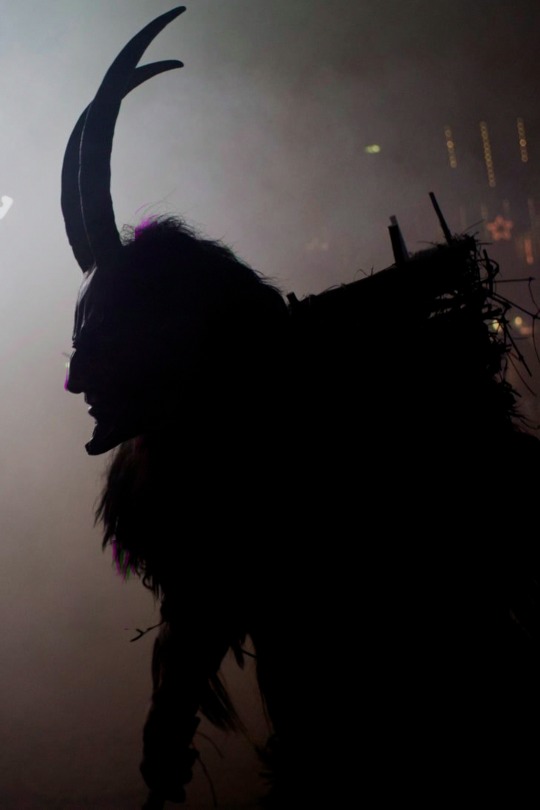
Christmas season is full of magical beings and creatures that travel through our world. Jolly old men from the north, elves that sleep in our homes, goats that give presents, the holiday season is full of all sorts of weird and wonderful characters. However, Santa Claus tends to me the most famous among them, and the most remembered in popular culture. This was, until some years ago, when a forgotten Christmas character rose in popularity in pop culture as an antithesis of good old St. Nick. I’m talking about Krampus, the Christmas Demon from German and Alpine lore.
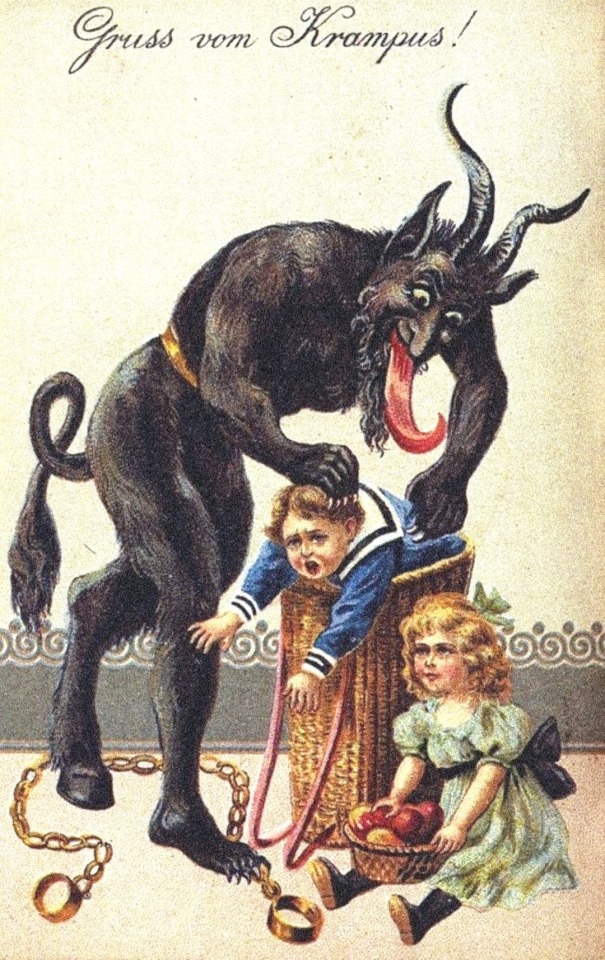
One of the reasons why I believe Krampus became so popular recently is because he’s a scarier and less commercial alternative to Santa. In older posts I talked about how people used to tell scary ghost stories during Christmas and how Christmas once had this spooky side to it. Then one day it hit me that, in a way, Krampus is exactly a call back to these traditions. While not a ghost, Krampus brings back the scary atmosphere to the holiday. People tell stories about Krampus, they dress like him, they fright their neighbors in these costumes. People in general like to be scared, and in particular, even though they won’t admit it now, children too. Krampus is celebrated because he brings back the fun that overly commercialized Santa took out from Christmas.
Jeremy Seghers, organizer of the first Krampusnacht festival held in Orlando, said this in an interview to the Smithsonian Magazine:
"The Krampus is the yin to St. Nick's yang. You have the saint, you have the devil. It taps into a subconscious macabre desire that a lot of people have that is the opposite of the saccharine Christmas a lot of us grew up with."

Krampus is mainly a holiday tradition from the Alpine region and Central Europe in general. His name is derives from the German word krampen, meaning claw. On the night of December 5th, the eve of Saint Nicholas Feast, Krampus, and Saint Nicholas himself go out in the streets to punish or reward kids. This makes him one of the Companions of Saint Nicholas, a group of holiday figures that would help him in punishing kids. While they do the punishment, jolly old Nick brings the kids gifts, in a sort of Good Cop, Bad Cop dynamic.
Our friend St. Nick fills the shoes of good children with fruits and sweets. Krampus carries birch branches for senseless beating the misbehaving ones. On his back he is often depicted carrying a sack or a basket. This is to carry the naughty kids to his layer for more torture later. He can also eat them, threw them out in the river to drown, or bring them straight to the depths of Hell. In some parts of Austria, Krampus presents the families with gold-painted twigs that are to be displayed year-round in the house, constantly reminding the kids of his ever-watching presence.
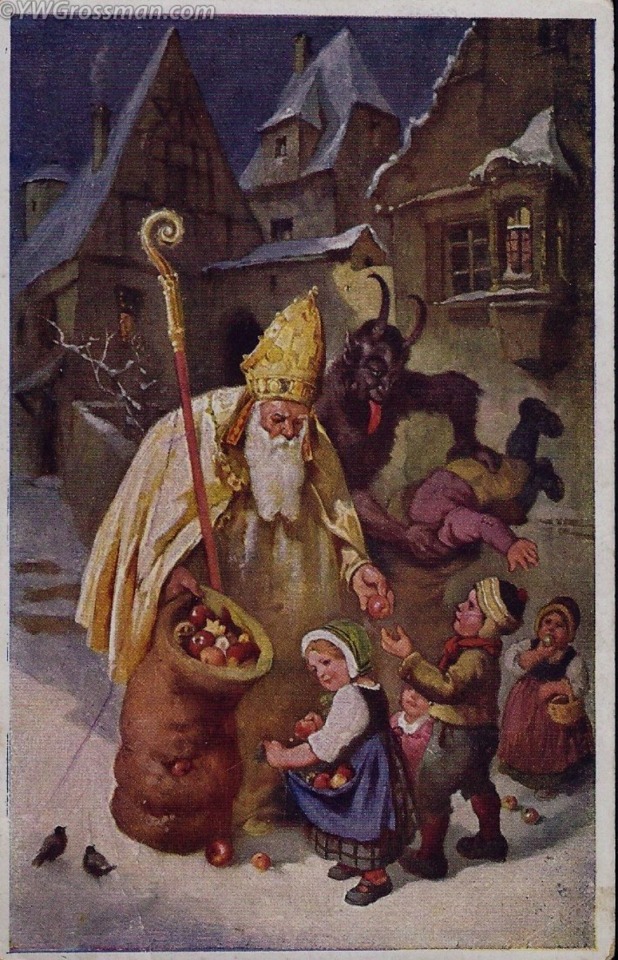
What lovable fellow!
It was common in the 19th century to exchange Gruß vom Krampus, “Greetings from Krampus” cards that contained humorous rhymes and poems. In these Krampus is depicted looming menacingly over children. In others the creature receives sexual undertones, pursuing scantily dressed women.

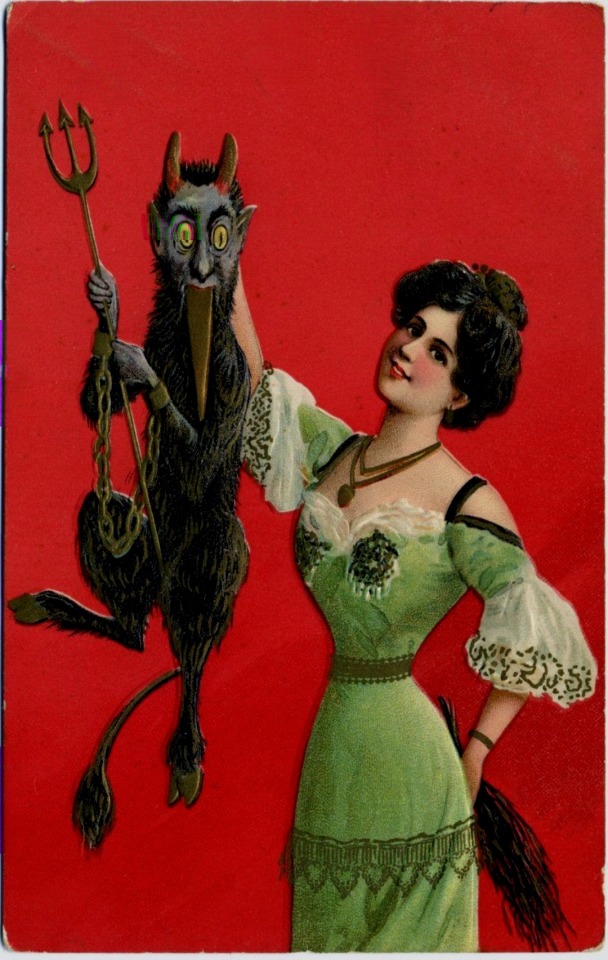
There is also the Krampuslauf, or, Krampus Run, where people dress up as him and parade through the street dressed in fur suits and carved wooden masks and carrying cowbells. This one is very important for understanding Krampus origins.
Now, no one really know where Krampus comes from. The most popular theory is that he was a fertility god from the Alpine Region before Christianity retconned him as demon. Scholars often link him, Pan, and the satyrs to the archetype of the Horned God. Some claim he’s the son of Hel, but I didn’t find any real or credible source to this.
What we do know is that Krampus has some connections to a goddess in the Alpine region called Frau Perchta.
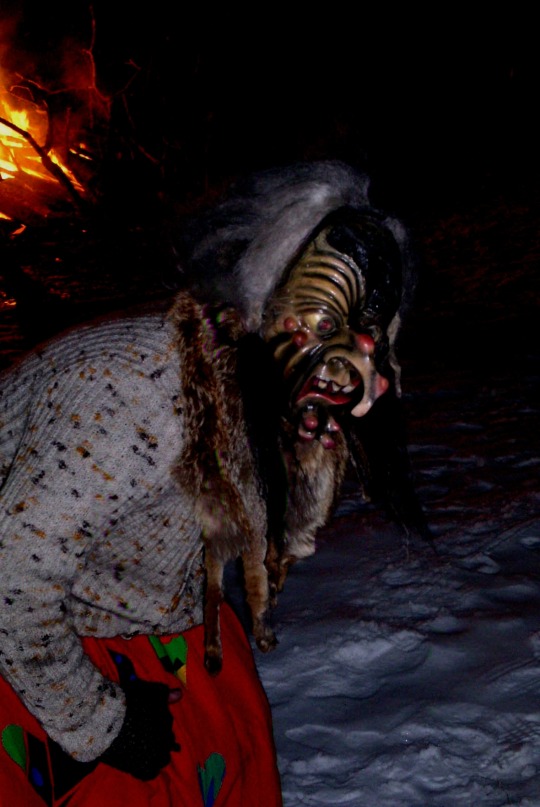
Now Frau Perchta is a very mysterious figure from the German folklore. She had many different names depending on the era and region. We don’t know a lot about her before Christianization, but what we do know is that in the folklore of Bavaria and Austria, she was a witch said to roam the countryside at midwinter, and to enter homes during the twelve days between Christmas and Epiphany. Good children would find a silver coin in their shoes. Bad children would have their bellies sliced open, their stomach and guts removed, and she would stuff the straw and pebbles in the hole left behind. She had two forms in which she could be encountered, beautiful and white as snow, or elderly and haggard.
Perchten is plural for Perchta. Originally, the word referred to female masks representing her, but the name come to refer to the animal masks worn in parades and festivals in the mountainous regions of Austria.
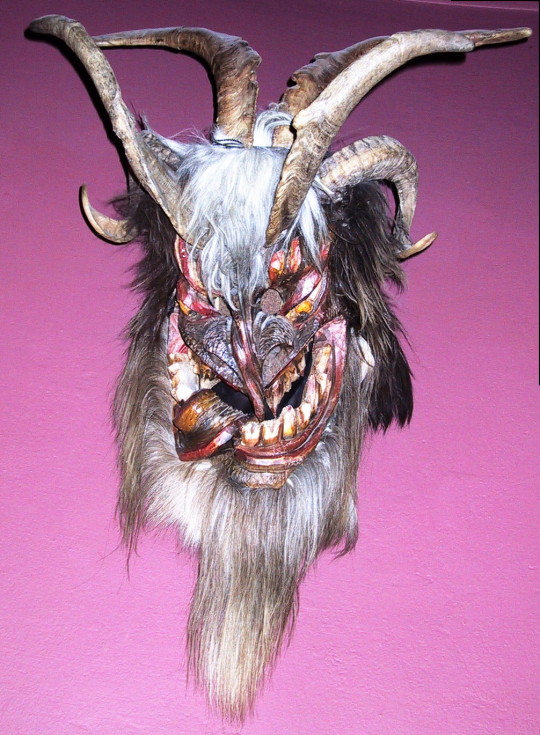
A Perchten mask
In the 16th century, the Perchten took two main forms: Schönperchten, "beautiful Perchten", or the Schiachperchten, "ugly Perchten”. The beautiful Perchten came during the twelve nights of Christmas and festivals to bring luck and wealth to the people. The ugly Perchten, who had fangs, tusks and horse tails which were used to drive out demons and ghosts. Men dressed as the ugly Perchten during this time and went from house to house driving out bad spirits.
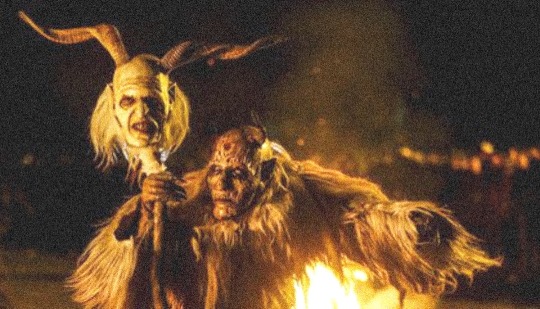
From the Smithsonian Magazine: A man dressed in a traditional Perchten costume and mask performs during a Perchten festival in the western Austrian village of Kappl, November 13, 2015. Each year in November and January, people in the western Austria regions dress up in Perchten (also known in some regions as Krampus or Tuifl) costumes and parade through the streets to perform a 1,500 year-old pagan ritual to disperse the ghosts of winter. (DOMINIC EBENBICHLER/Reuters/Corbis)
People would masquerade as these devilish figures and march in processions known as Perchtenlaufs. The Church didn’t like these creatures and tried many times to ban these practices, but due to the sparse population and the rugged environments within the region, the ban was useless.
In Catholicism, St. Nicholas is the patron saint of children. His saint day falls in early December, which helped strengthen his association with the Yuletide season. A seasonal play that spread throughout the Alpine regions was known as the Nikolausspiel, "Nicholas play". In these plays St. Nick would make questions about morality and reward children for their scholarly efforts. Eventually the Perchtenlauf, in an attempt to pacify the Church, introduced Saint Nicholas and his set of good morals. Krampus, the in-chains helper of Saint Nicholas, was then born.
In 1975, anthropologist John J. Honigmann wrote that:
"The Saint Nicholas festival we are describing incorporates cultural elements widely distributed in Europe, in some cases going back to pre-Christian times. Nicholas himself became popular in Germany around the eleventh century. The feast dedicated to this patron of children is only one winter occasion in which children are the objects of special attention, others being Martinmas, the Feast of the Holy Innocents, and New Year's Day. Masked devils acting boisterously and making nuisances of themselves are known in Germany since at least the sixteenth century while animal masked devils combining dreadful-comic (schauriglustig) antics appeared in Medieval church plays. A large literature, much of it by European folklorists, bears on these subjects. ... Austrians in the community we studied are quite aware of "heathen" elements being blended with Christian elements in the Saint Nicholas customs and in other traditional winter ceremonies. They believe Krampus derives from a pagan supernatural who was assimilated to the Christian devil"
Is worth noting that this is exactly what happened to the Yule Goat. He was a pagan symbol, people dressed like him to keep winter spirits at bay, but the Christians demonized him. There are illustrations of Saint Nicholas or of Father Christmas riding the Yule Goat during Christmas and these were meant to represent the power of God over the power of the Devil. Krampus is represented in chains by the same reason. However, the Yule Goat came to become a gift-giver and a more positive force in holiday lore, with people dressing as goats to deliver gifts to their families in the 19th century. Krampus didn’t have the same luck. I really wonder if the Yule Goat and Krampus came from variants from the same or similar cultural traditions, but that took drastically different routes.
I must say that, although I'm more in the team Santa, I learned to love Krampus over the years. It’s undeniable the amount of fun he brought to those who wanted something a little more darker and creepier in the holidays, and as someone who identifies itself as 90% lover of cheesy, cutesy and sappy stuff and 10% lover of everything earie and macabre, the idea of a monstrous boogeyman in the shadows of good old Santa Claus is fun. I personally think there’s enough space for both, the terrifyingly scary and the joyful jolliness.
Fun fact: Krampus, the one people rescued from German obscurity to combat the overly commercialized Christmas, is now being criticized as being too commercialized. C'est la vie
Story time: In my country I once heard the tale of a guy that went as Santa to deliver Christmas presents to children in a poor community. He brought many gifts and toys with him. The children loved them, until there were no more gifts to be delivered. The remaining children and their parents became so angry that they chased away the guy, throwing rocks at him. The guy came to them with free stuff, helped as much as he could, and people still threw rocks at him and chased him away, almost seriously hurting him.
I admit, there are cases where Krampus is truly needed 🤣🤣🤣
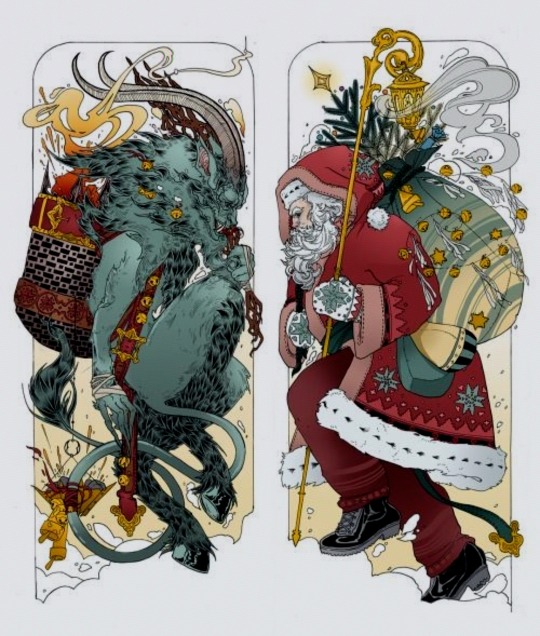
Art by Helen Mask
#The Creatures of Yuletide#christmas#holiday season#gruss vom krampus#krampus#Greetings from Krampus#Gruß vom Krampus
73 notes
·
View notes
Text
The Real Story Behind Krampus (2017), And The 17 Other Terrifying Christmas Tales And Traditions You NEED To Know About
Christmas is a time for family, a time for laughter, and a time for drinking volumes of alcohol that make your cousins concerned about your emotional wellbeing.
But most importantly, it's a time for demons to hunt down children and stuff them full of straw and pebbles. No, I’m not talking about the Eastenders Christmas Special - I’m talking about the Christmas traditions they don’t put in Hallmark movies.
As Christmas has been celebrated for 2000 years, it has amassed a collation of equally terrifying traditions and monsters that only the dark corners of history could conjure up.
Although confirmed by the Dickensian tradition of sharing ghost stories (see Matthew Mcconaughey movie - or failing that some old book about poverty in Victorian Britain), it seems we’ve forgotten the true terror behind the most wonderful time of the year!
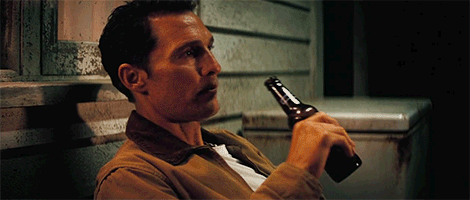
So, as your favourite paranormal blogger, I’ve taken it upon myself to bring together everything creepy ‘bout Christmas.
Today’s post is gonna take y’all through the mythical monsters you should be on the lookout for, plus the Christmas traditions that bare a dark, twisted backstory.
Which is all of them.
Let’s get spooky!
First, Let’s All About The Monsters Of Christmas
Hands up if you’ve watched Krampus (2017).
Here’s the trailer: https://www.youtube.com/watch?v=h6cVyoMH4QE
It might not be Love, Actually, nor will it ever score a set of great reviews, but it got everyone talking about the mythical creature titling the film.
Need a summary?
This dark-comedy/horror film centres around a dysfunctional family at Christmas. When the youngest child loses faith in Santa, he rips up his letter to him, sending a signal to Krampus that he has lost his Christmas spirit and thus must be punished!
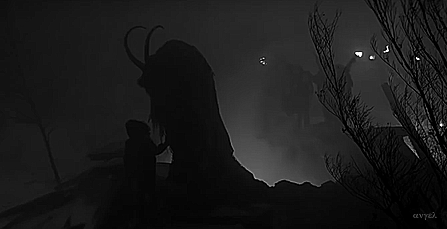
Okay, this film doesn’t fit the actual legend that well. But the kid does get dragged to hell - and unfortunately, that’s what sticks closest to the creature titling the film.
On top of this, the movie features the classic mysterious European grandmother that has a story about the war (as a European I can confirm this). But her story isn’t about an air raid, or some long-gone past ruler; instead, it explains a twisted tale regarding the most famous companion of Father Christmas.
That being said, it provides an introduction that only scratches the surface of the mythical creatures of Crimbo:
Krampus is the half-goat, half-demon creature that is often witnessed wandering ‘round with Santa Claus. Concieved in the pre-christian era in central europe, his aim of existence was to punish naughty children.
“So, Santa provides for the nice kids, Krampus provides for the naughty kids? Got it.”
If only it was that simple.
Krampus’s family tree is more twisted than the British royal family - and has a similar collection of dodgy relatives:
Son of the Norse goddess, Hel (ruler of the underworld and the dead), Krampus is a Perchten, a race of beasts born to scare away Winter. Never heard of ‘em? Well, you’ve probably heard of his grandfather, then: Loki.

Given his famous hegemony, it follows that he is always believed to be the Horned God of the Witches, and sticks to a devilish image.
With a dark, hairy body, large fangs and a tongue hanging far below his bottom lip, beast-like is an understatement. Accessorising his frightful look is a grasp of birch branches or a whip, as well as a sack or basket (to put children in and take to hell or save for a quick drink and snack later), and chains.
However, the chains part is still subject to debate: some believe it is an attempt to bind the devil by the Catholic Church in attempt to control him, while others claim it is because Krampus is Santa’s slave.
This directly relates to the position of Krampus and his fellow monsters - they are all believed to be Santa’s companions.
So, we know who Krampus is. But did you know he has a whole night devoted to him?
Krampusnacht falls on the 6th December, a day from which people put on masks and get drunk, scaring kids. Alternatively, you can dress up and hand out coal, mirroring the Krampus spirit! Nevertheless, both serve as a reminder to children not to be naughty, as does the bundle of golden birch branches you can have in your house.
Now, who’s ready to get their feminist on?

Frau Perchta is the female counterpart of Krampus.
This goddess-monster goes about giving good kids silver coins, and giving naughty kids, uh, well, death.
She’d slice ‘em open, and stuff ‘em full of straw and pebbles. But her backstory goes much further than simply murdering children: as she oversees spinning as a part of the 12 days of Christmas, she focuses on people that get their work done.
And if you slack? Then you gon’ get murdered.
Given her name, it’s obvious that like Krampus, she’s a beast-like creature. But her animalistic tropes only go so far as her feet - just like Krampus’ single goat hoof, she has a swan foot.
“So, she’s a swan?”
Nope - she’s either regarded as a beautiful young woman, or an old crone.
Classic Patriarchy.

Next up is another animal, but this time, it comes in the form of a cat. Unfortunately, the Yule Cat is less Instagram, and more deadly. Yep - this Icelandic beast eats the kids that fail to complete their chores before Christmas.
Just like Frau Perchta, it can be traced back to farmers attempting to scare their workers into getting shizz done. If they hadn’t processed the autumn wool, they’d be eaten by the cat. If they had, they’d receive new clothes.
You’d better be thankful for those socks, then!
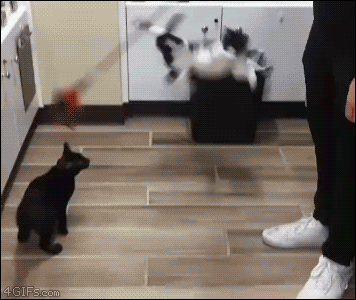
But it turns out the Yule Cat isn’t the only monster from Iceland. In fact, he’s actually the pet of a family of ferocious Christmas beasts!
Gryla and Leppaludi are a couple hell-bent on detecting naughty children. Gryla, the matriarch of this famalam - is a Norse giantess, who wanders round each and every village in iceland. Once she’s found said children, she eats them.
Often she is described as a beggar, asking for parents to turn over their disobedient children so she can chuck ‘em in her sack, and add them to her signature stew!
Her husband - well, third husband but who’s judging - Leppaludi, is what the Daily Mail would label a benefit-scrounger as he hangs about in their cave all day. On top of this is their 12 children: The Yule Lads.
(God, this has a Daily Mail story written all over it.)
Each lad has a different, um, quirk.
One harasses sheep. One steels tupperware - no, seriously, he makes a point of stealing pots with lids. And another steals candles from children.
So that’s Iceland covered - let’s head back to continental Europe!
Hans Trapp is our next contender for the ultimate creep of Christmas. Trapp is a resident of Alsace-Lorraine, and comes from near the border of France and Germany. But what’s really terrifying about this monster is that he once existed.
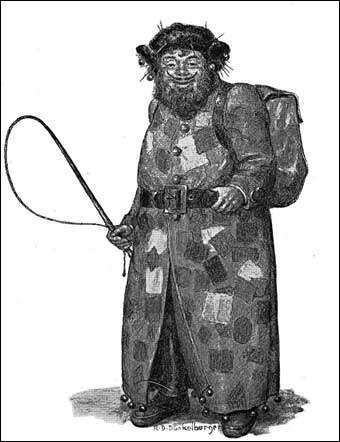
Hans Von Trotha was a French Knight and man of particular political distinction. From his feuds with the church, to his ever-roaming spirit after he died, the following myth was by no means a random creation. However, the backstory to Hans Trapp took a bit of a detour from his past:
Trapp was reportedly a Satanist who would kill children. Yeah, you can see a theme here…
This rich, greedy man was excommunicated by the church, and then exiled to the forest where he would hunt children. Well, he would until struck by a bolt of lightning sent by God. But despite his rather dark past, his backstory is less really-demonic, more redemptive.
A bit like Krampus, he seeks to remind kids to be virtuous, teaming up with St. Nicholas to ensure children would be nice.
Next is Romanian Werewolves.
Yep, that’s plural.
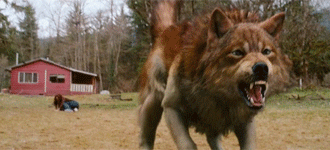
Sure, these man-beasts show up during the full moon, but also makes a point of unleashing their true forms at Christmas. This has merged with caroling in Romania - dressing up as animals and pissing off people busy having a cheeky Baileys rather than see their family is a common occurrence there.
Oh, and they go around and tell you not to have sex.
No, seriously, you aren’t allowed to have sex on Christmas Eve cause Jesus or somethin’.
The other Christmas mythical creatures include:
Le Pere Fouettard, some fella who tags along with St. Nick, delivering lumps of coal to naughty kids. Well, when he’s not beating them up, that is!
Knecht Ruprecht joins Santa on his rounds too, but he isn’t like Pere, don’t worry! He kidnaps children, instead.
Next up is Zwarte Piet, one of Santa’s helpers who listens at the chimney of family homes to deduce if kids have been naughty or nice. Guys, we got a wholesome helper! Wait - people dress up in blackface to celebrate him?
I think we can all agree that racism is far scarier than anything else on this list…
Lastly, we have Belsnickel. And don’t worry, there’s no racism here. This bloke clad in fur and random clothes asks kids if they’ve been naughty or nice during the year.
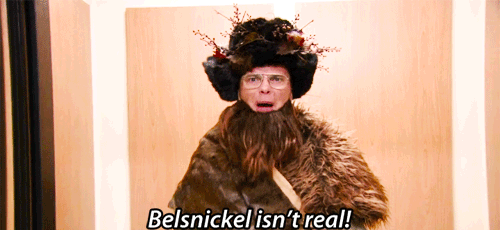
Let’s Talk About The Terrifying Traditions
Well, we did it, guys!
We made it through the monsters behind a Merry Christmas.
And you can rest easy knowing these are all mythical creatures that can add a smidge of spook to your Christmas. But now it’s time to discuss the spooky side to the traditions we pull out of the attic year-upon-year.
So, no, these aren’t based on myths or religion - its based on historical fact!
Great.
Anyways:
If there’s one thing that defines Christmas - and is currently crippling my bank account - its gift giving.
Thinking of giving someone scissors for the most wonderful time of the year? It will literally cut your friendship or relationship in two. And shoes? The receiver of your gift will metaphorically walk away from your relationship.
But if you’re looking for a more, uh, positive gift, a wallet or purse should be on your shopping list, instead.

Wallets with money in them are believed to ward off demons, ghosts, and all other scary things.
Another creepy Christmas fact is the historical origins of mince pies. As a Brit, seeing Americans attempt to comprehend mince pies always figures as a solid meme. But the origin of it doesn’t steer too far from ‘Murican attempts to replicate this Christmas treat.
Back in the 16th century, cannibals would add human meat to pies, selling it off as actual meat. Oh, and this parallels some vague rumour of Santa being a cannibal. Basics, a holy man told him to give gifts to kids instead of eating them.
In some strange and convoluted way this somehow chocks up to mincemeat now insinuating that there is no meat in there, instead.
*shrugs*
Speaking of tasty treats, why not make sure you stick to the rule of the Baker’s Dozen at Christmas?
When bakers would make batches, they would provide 13 of something instead of a dozen in case something turned out wrong. But they would also provide an extra roll, or a bun, at Christmas!
It’s for that reason that on the 12th day of Christmas, you have to take down your Christmas tree. Fail to do so? You’re gonna have to keep it up all year, then. It’s a mouldy pine tree, or its bad luck.

Our next tradition stakes it claim as the twisting of a Crimbo icon: it’s Santa Claus, himself.
But this time, he takes on an urban legend that I’m sure many actually believe: understandably, ‘santa’ can be traced to ‘satan’, as if it is the unholy being himself but in disguise. And ‘claus’? It can be translated to ‘hoof claws’, a running theme we see with the monsters like Krampus.
So, could it be the devil in disguise?
Satan aside, who else likes trooping up to midnight mass and singing about the JC?
Well Christmas carols - and even carolling itself - actually sticks to a relatively dark past. Take Good King Wenceslas - this bloke let in peasants and encouraged them to join his bountiful feast!
Unfortunately, his charitable efforts were not rewarded. He was stabbed with a lance repeatedly outside a church upon his own brother’s orders, and was then dismembered.
Yikes.
Historically, carollers would partake in similarly violent activities, demanding food and drink from their audience. Heck, they would even so so far as to start attacking, raping, and destroying their property!
Guess it wasn’t a very Silent Night, then…
Our penultimate tradition is that of the Nutcracker: Whether you’re watching it, or using it to have a Christmas-specific nibble, there’s no doubt that this is pretty popular image of the festive season.

But - and it’s a big ol’ ‘but’ - it’s based on a truly terrifying story.
No, there’s no ghosts, no ghouls, and certainly no demons. But there is a child marriage.
The story goes that a girl, Marie, sees a nutcracker come to life. Her Grandfather than launches into this story of how men can be cursed with the ugliness of a nutcracker. She replies by saying she’d marry one no matter how they looked.
She is then whisked away into a magical world from which she marries a nutcracker.
This all goes down whilst she is 8 years old.
Our final tradition of terror is less about the abuse of young girls, and more about evil beings breaking into your house. Merry Christmas?
See, you’d think that people coming down your chimney is reserved for one bloke in particular, but it turns out that European tales of malicious spirits taking the same route is a common tale frequently told.
Belsnickel does the same, as do Greek goblins in order to terrorise the residents of the house.
So - What’s Your Verdict?
Which tradition left you shook?
And what Christmas film are you now going to watch to try and wipe this from your brain?

Be sure to hit follow to see a real spooky story tous les jours (everyday for the unsophisticated among us)!
At this point, I would tell you to have a Merry Christmas, but I think a safe one where, you know, you don’t get dragged to hell by Krampus, is best.
#krampus#belsnickel#the office#horror movie#love actually#elf#christmas films#christmas movies#best christmas movies#best christmas gifts 2019#gift ideas#christmas movies on netflix#christmas movies 2018#midsommar#horror movies#the conjuring annabelle#conjuring#suspiria#scary movies#The conjuring#the conjuring 2#it follows#horror movies 2019#Best horror movies 2019#horror film#based on a true story#christmas story#will ferrell#krampus origins#mythical creatures
160 notes
·
View notes
Text
The Creatures of Yuletide: The Companions of Saint Nicholas
Do you know what Santa has in common with Batman? They don’t work alone, but adaptations what you to believe they do
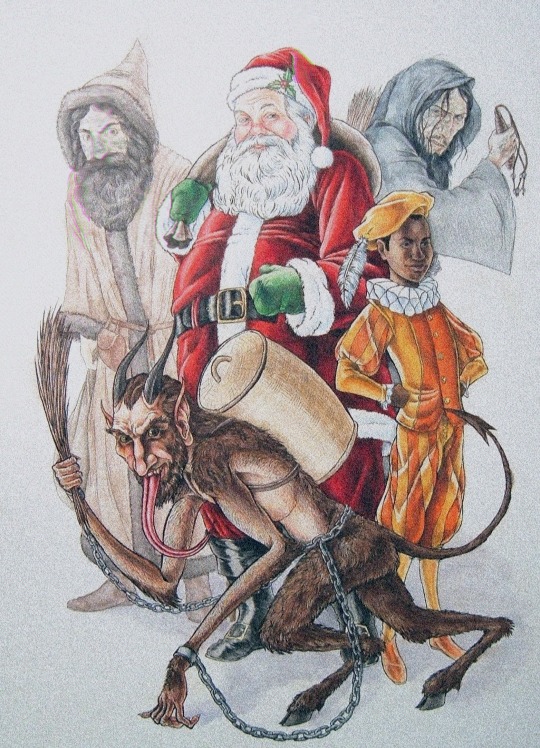
Art by Spearhafoc on Deviantart
A common motif in European Christmas lore is that when old St. Nick goes to deliver gifts to well-behave children he often doesn’t go alone. The Companions are the figures who would assist him in his role as a gift-giver, and they change a lot depending on the time period and local.
In theory, these companions are local variants of the same guy, a somber and darker figure that would punish the bad kids, while Nicholas himself would reward the good ones. Krampus, who I talked about in my last post, is one of these, and his characterization as a half-goat demon comes from the context of the alpine region. The context of the place in question and the way the legends about St. Nicholas are told there shape the form of the sidekick that comes with him. In some places the companion assumed the form of a terrifying old man, in others, he stays in the middle ground with Krampus, as scary man with horns.
Some of them came to a more positive light is recent times and are considered now the Robin to St. Nick’s Batman.
I will talk about three of them today.
Quick note, where’s my Christmas movie where Santa is a (Batman voice) “I work alone” type of hero and then a young wide-eyed sidekick comes in and says, “Teach me in the ways of Christmas, Santa!”. I would watch it
Knecht Ruprecht
“From out the forest I now appear;
To proclaim that Christmastime is here!
now speak, what is there here to be had?
Are there good children, are there bad?”
“Knecht Ruprecht”, Theodor Storm
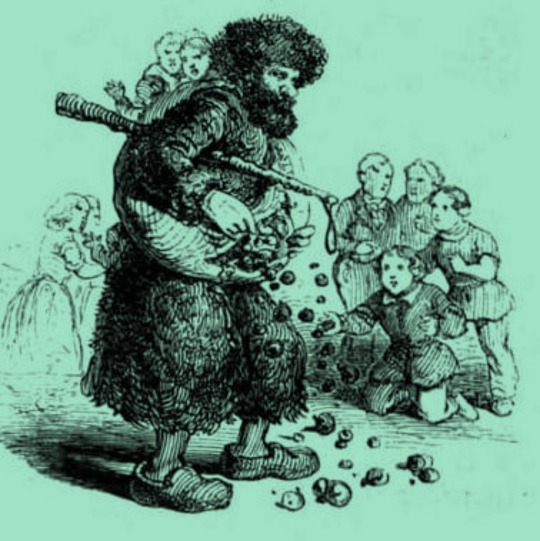
In my last posts I made a mistake. I associate Krampus with Germany, but now, it seems like he’s more from the Austria and the Alpine region as a whole. Germans have the Knecht Ruprecht, and instead of being a half-goat demon from Hell, he’s a sinister man with a black beard bearing a black furry robe, a chain and bells along with a bundle of birch sticks to punish the naughty children. The word Knecht in German means servant or farmhand, so in English his name would be Servant Ruprecht or Farmhand Ruprecht, and you can even get a Rupert or Robert if you anglicized his name.
It seems that in traditional German Christmas lore, it’s the Christkind, a magical version of baby Jesus, who brings gifts on Christmas Eve. However, Saint Nicholas do appear, but only on December 5th, the eve of his feast, bringing along Ruprecht. St Nicholas would open the big book to see if the devil had written anything bad about the children. Then Knecht Ruprecht would ask them if they knew their prayers. Kids who had been good and could recite the Lord’s prayer would be given apples or nuts by Nicholas as a treat. Bad children would receive sticks, coal, or could even be stuffed in Ruprecht’s sack and be dragged away to never be seen again.
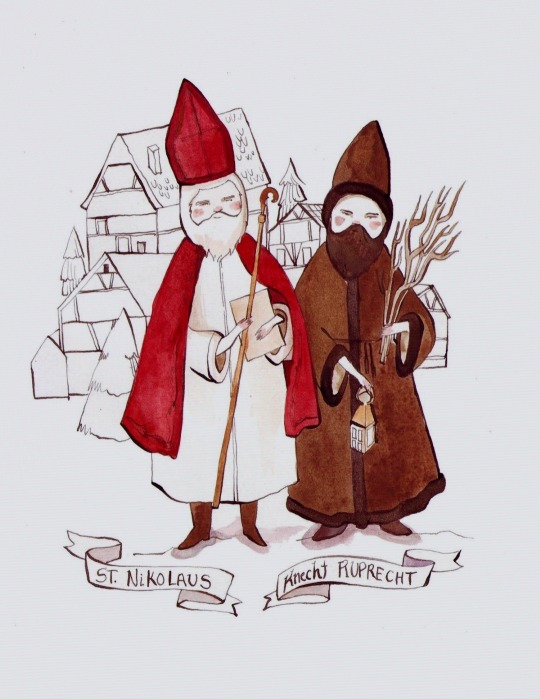
I don’t know if this is true, but during my research I learned that some German parents went to great lengths to teach their misbehaving kids a lesson. They actually had someone to take them away, and some even remember being taken out to the woods. Don’t mess around with Germans!
His backstory is nebulous. Remember what I told, variants of the same guy. In some tellings he is closer to Krampus, with horns in his head as a result. In others he is a wounded foundling that St Nicholas rescued and raised. And in others he is told to be the butcher from St. Nicholas’ lore, that would inspire our next companion.
Père Fouettard
French for, “Father Whipper”. One of the darkest and most vicious companions.
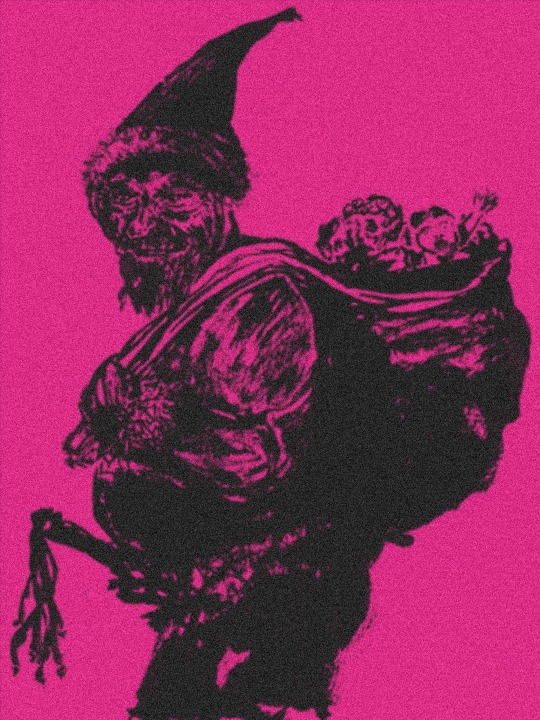
There’s a very dark legend about St. Nicholas. A butcher (in some versions an innkeeper) kills three children that were on their way to enroll in a religious boarding school. In some versions he and his wife drugged the kids, sliced their throats, cut them into pieces and put them in a salting tub. When St. Nicholas turned up at the door the butcher attempted to ingratiate himself to his visitor by offering him his best meat, the children. St Nicholas immediately discovered the horrible crime and brought the boys back to life and punished the butcher by forcing him to work alongside him for all eternity.

In France, it is Père Noël, Father Christmas, who distributes gifts to good children, generally on Christmas Eve, except in eastern France where St. Nicholas Day and the night of December 5th still are observed. He is traditionally accompanied by Père Fouettard.
Pere Fouettard is portrayed as a man with a creepy face, disheveled, messy hair, and a long white beard. He is often described as clothed in murky robes, covered in soot, wearing a scruffy hat and buckled shoes. He follows Père Noël/St. Nicholas from house to house, acting as his punisher, dispensing coal, and beatings to the naughty. In some tellings, he carries a wicker back-pack to carry naughty children away. It is also believed that Pere Fouettard tells St. Nicholas, which children misbehaved during the year, and consequently, they are deprived of the treat. Some even say that, he cuts out tongues of children who are caught lying.
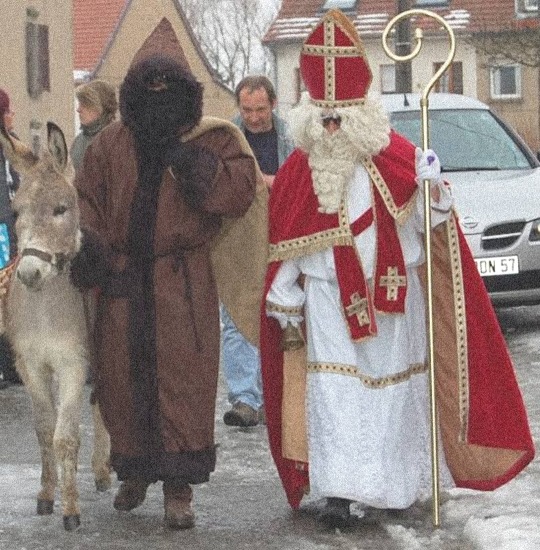
Why in the world St. Nick would trust a cannibal child killer to be near children is beyond me.
Zwarte Piet, “Black Pete”
Oh boy! You know where this is going!
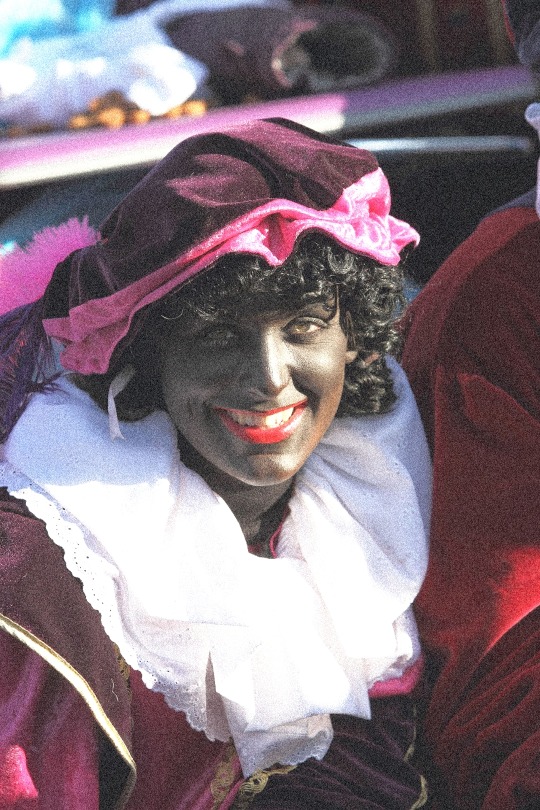
Zwarte Piet is that type of character that the more you research, the worse it gets
Sinterklaas is the form that Saint Nicholas assumes in the Netherlands and Belgium, and he is the main source for the American Santa Claus.

In the first Saturday after 11 November, he arrives by a steamboat at a designated seaside town, coming from Spain. In the Netherlands this takes place in a different port each year, whereas in Belgium it always takes place in the city of Antwerp. The steamboat anchors, then Sinterklaas disembarks and parades through the streets on his white horse, welcomed by children cheering and singing traditional Sinterklaas songs. He then parades through schools, hospitals, and shopping centers until the evening of December 5th, where he would deliver gifts to the children.
I will admit, this sounds so much cooler and more fun than modern day Santa.
Sinterklaas has a sidekick, a moor from Spain, Zwarte Piet, the Black Pete, usually portrayed as a blackface caricature, wearing a colorful Renaissance attire in addition to curly wigs and bright red lipstick. His role is to be Nicholas’ servant, a rascal and a prankster, amusing children and distributing traditional sweets during parades and public events. In older lore he was said to act just like the other companions, punishing bad children with coal in their shoes and threatening to kidnap them.
Some older traditional Sinterklaas songs claim that he and Sinterklaas could even drag the naughty kids to their home in Spain, were they would force them to work in their workshop for an entire season or longer. They essentially used slave labor! 😬
Some link him and Sinterklaas to Odin, and Huggin and Munnin. Huginn and Muninn would often fly through the Nine Realms, bringing a report of who was good and who was bad back to Odin. So, the black guy's role may have come from Odin’s crows 😬
Others link him to Krampus and Krampus-like figures, evil demons who were show to be under the control of Saint Nicholas and the power of God. According to a theory firstly proposed by Karl Meisen, Zwarte Piet and many other companions, like Krampus, were inspired by these enslaved demons.
Zwarte Piet and many modern traditions about him and Sinterklaas came from a children's book written school teacher Jan Schenkman, in 1850. The book was titled Sint Nikolaas en zijn Knecht, "Saint Nicholas and his Servant". In Schenkman's version, the devil figure that followed St. Nicholas was changed to a Moorish helper.
More modern lore presents him as a more of a Robin-like figure, a more heroic and charismatic sidekick. He is said to be a Turkish orphan rescued by St Nick, or an Ethiopian slave freed by him. Or he is just completely whitewashed, and the dark skin is explained as the ashes and ambers from the chimneys.
He is very controversial, and said to be a remnant of colonialism, slavery and racism. Some say he may be even inspired by a slave brought by one member of Dutch Royal family in market in Cairo in the mid-19th century.
As far as I know, Netherlands is very divided into those who want to keep the tradition, and others who see him as racist stereotype. A lot of protests and acts of violence had come from this simple problematic character. It’s very common for neo-nazi groups who want to keep him as he is to brutally attack and threw racial slurs on those who want a revised version of the character or his removal from the holiday tradition altogether.
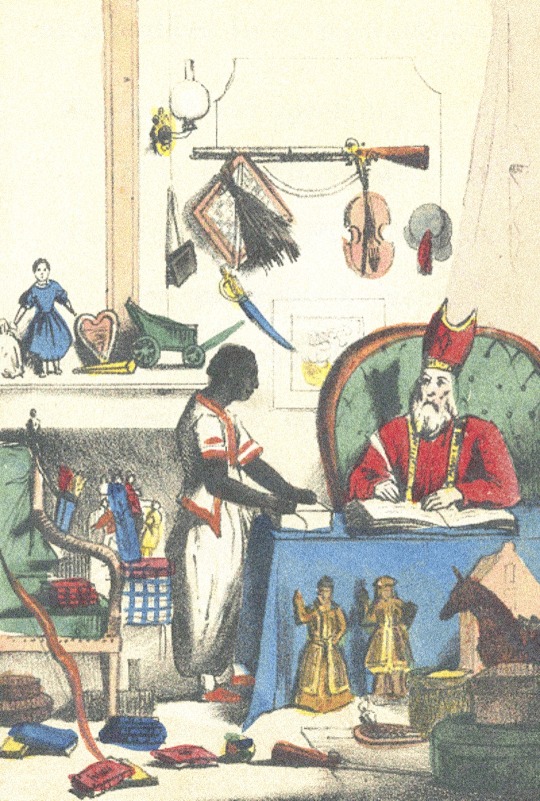
22 notes
·
View notes